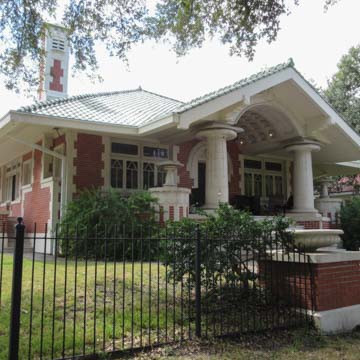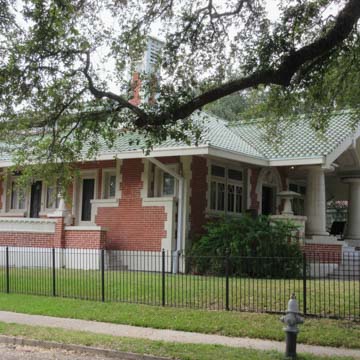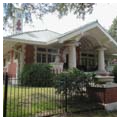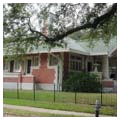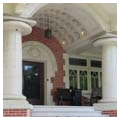H. Jordan MacKenzie (1870–1956), who arrived in New Orleans from California in 1904 and departed for Texas in 1917, designed several houses in the city that were influenced by Arts and Crafts or Secessionist forms. The bright blue tile roofs he introduced to New Orleans earned him the nickname “Blue Roof” MacKenzie. Among his houses with this feature was the one he built for himself in 1909 at 6339 West End Boulevard, where he lived for two years. Unfortunately, most of his houses have been altered. Although this house’s roof is of green tiles, the low, broad residence set on a raised basement and built of red brick with concrete details reveals MacKenzie’s interest in expressive forms, textures, and colors. The coffered entrance porch, reached by a double set of stairs, is supported on over-scaled columns with capitals that look as if they are oozing from their hefty shafts. The house is sheltered by a sweeping roof with deep unsupported overhangs that adds a Prairie Style flavor. The house, built for contractor William H. Kane, was shortly after acquired by steamship agent and broker William Cowley.
You are here
William J. Kane House (William Cowley House)
If SAH Archipedia has been useful to you, please consider supporting it.
SAH Archipedia tells the story of the United States through its buildings, landscapes, and cities. This freely available resource empowers the public with authoritative knowledge that deepens their understanding and appreciation of the built environment. But the Society of Architectural Historians, which created SAH Archipedia with University of Virginia Press, needs your support to maintain the high-caliber research, writing, photography, cartography, editing, design, and programming that make SAH Archipedia a trusted online resource available to all who value the history of place, heritage tourism, and learning.






